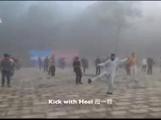 Six sealing four closing: Must be like inside a round cylinder. Muscle must rotate around bone. Don’t move. Hand must be like inside tube and body must adjust to be aimed correctly. Hand out, elbow in can only be done if front lat goes down to the rear arch and front kua rotates to curve up to connect to the rear shoulder. Pull elbow back to be in alignment. Step in a little bit with just the lower body to fill space. Don’t push. If one part is off it throws the entire body out of alignment.
Six sealing four closing: Must be like inside a round cylinder. Muscle must rotate around bone. Don’t move. Hand must be like inside tube and body must adjust to be aimed correctly. Hand out, elbow in can only be done if front lat goes down to the rear arch and front kua rotates to curve up to connect to the rear shoulder. Pull elbow back to be in alignment. Step in a little bit with just the lower body to fill space. Don’t push. If one part is off it throws the entire body out of alignment.- 18 posts in the body… they cannot collapse into each other.
- Don’t move knees. Turn with waist. Don’t push. Worked this with Spencer.
- Body must become a bow. Rear of body stretches back and down, connecting to rear foot. Aim onto straight line/dot. Don’t push.
- First closing: pull arm onto dantian, push into it with rear foot, adjust kua so that the front foot can freely move/kick
- My body is too stiff and the joints can’t turn. If someone does something, I can’t do anything and get hurt.
- Arms make curved shape, using knife hands. Body goes down. Back has a peak that goes back. Half on hands, half on back.
- Six sealing four closing: front arm orientation is up, rear hand pulls diagonally down. This produces a dot on the opponent’s arm. As soon as you set up the dot, the front leg (which has been lightly laying in wait) pops back in to opponent’s front leg.
- Six sealing four closing COUNTER: the upper arm, forearm, and waist must be independent. As soon as the opponent traps your arm and set up the point, you let him have the arm and move in. Then rotate arm. Then nudge in. Then rotate the forearm again.
- Anchor and open the shoulder when caught.
- Shoulder rolling. Go loose at first. Then make it tight and grind it out.
- Chinese cooks have something called a fire schedule. The ingredients could be simple, but the specific timing of the flame settings make for wide variation. This is the method we must also use. All the Taiji ingredients must be combined with proper timing and sequence to do it right.


